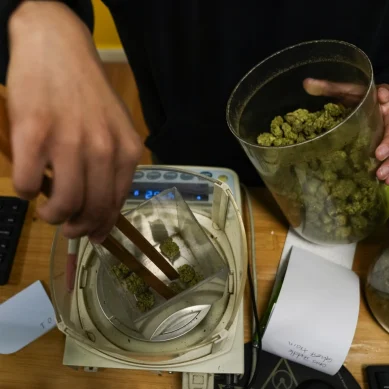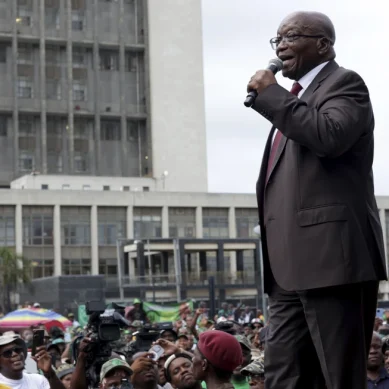
I’m not a TikTok person. I’m too old. But when I finally ventured onto that popular but much-maligned app, which traffics in short videos and hot takes, I was surprised to find many videos about the Doomsday Clock.
It’s nothing like a conventional timepiece, of course. It’s meant to show how close humanity has come to nuclear Armageddon – to the proverbial “midnight.”
When it comes to TikTok content providers, I wouldn’t normally think of the Bulletin of the Atomic Scientists. It’s a deeply serious organisation founded in 1945 by physicists in the wake of the atomic bombings of Hiroshima and Nagasaki. The clock was invented two years later by landscape artist Martyl Langsdorf as a way of graphically illustrating the dangers posed by nuclear weapons.
In its 76 years of existence, its hands have been moved 25 times, but never more ominously than in January of this year!
And no need to look further than TikTok to see what happened. Amid all the tweens trying to jumpstart the next viral craze, a 30-second video features five representatives of the Bulletin‘s science and security board frozen in place as a voice intones, “We move the clock forward, the closest it has ever been to midnight.” Then two of them pull a cloth off it and add, “It is now 90 seconds to midnight.”
On TikTok, versions of this video got hundreds of thousands of “likes” and thousands of comments. Mind you, that’s a blip compared to the videos of even minor celebrities. Still, I found myself scrolling through the comments, many of them versions of “Does this mean I don’t have to pay my mortgage/bills/ taxes?” Others had lines like “Someone call the Avengers” or asked if it had anything to do with Taylor Swift’s Midnights album. This being the Internet, there was all too much cursing and all too many oblique emojis, as well as people poking fun at the awkward staging and long stretch of silence in the video.
Mixed with such inanity were expressions of genuine fear, confusion and distress over the possible immanence of nuclear war. That is, of course, what the clock, as a salient piece of public art, is supposed to do: generate conversation, spark inquiry, and lead to action. As artist Sam Heydt observes, the Doomsday Clock should remind us that “the edge is closer than we think. In a time marked by mass extinction, diminishing resources, global pandemic and climate change, the future isn’t what it used to be.”
One hallmark of TikTok is reaction videos where creators split the screen to show their response. In one, a young white woman reacts this way: “Are we supposed to be scared? My generation is never going to have retirement, never going to own a home. I’m living in a van.”
I get it: there’s so much that seems more immediate in our world – school shootings, police violence, bank collapses and inflation, to name just a few. Who even has time to notice now that the future isn’t what it used to be?
But embedded somewhere in any of those in-your-face issues, whether we know it or not, are nuclear weapons, threatening the end to it all. Certainly, the Pentagon knows it, since (whether you’ve noticed or not), it continues to invest your tax dollars in nuclear weapons, big time.
Between 2019 and 2028, the United States is on track to spend at least $494 billion or about $50 billion a year on its nuclear forces, according to a Congressional Budget Office assessment. Analysts actually estimate that Pentagon plans to “modernise” – yes, that’s the term – its nuclear arsenal could cost you as much as $1.5 to $2 trillion in the coming decades.
The clock has never been so close to midnight and the Bulletin of the Atomic Scientists is using every tool at its disposal to keep clanging the alarm bell. It even has a Doomsday Clock playlist on Spotify, while its 90-second clock announcement was briefly front-page news at the Washington Post (the front of their Science section, anyway) and the New York Times. Still, we live in such an atomised (excuse me for that!) and polarised media environment that it’s increasingly hard to penetrate the noise cloud.
Nuclear weapons, once a top-of-the-line issue for so many Americans, have faded into, at best, a background hum. So, I wonder, what happens after the Doomsday Clock reaches midnight? What’s next for that metaphor? Or as the seconds are shaved away amid a war in Ukraine that could always go nuclear, is it time for an entirely new metaphor, something (excuse me again!) more explosive?
Then, of course, there’s that other great danger to us all, climate change, which, it seems, doesn’t even need a metaphor. The alarm of raging wildfires, unbelievable floods, megadroughts, fiercer storms, fast-melting glaciers and disappearing rivers leaves the very idea of metaphors in the dust. Climate scientists are blunt to the point of bruising on this.
What part of “there is a rapidly closing window of opportunity to secure a liveable and sustainable future for all” don’t you understand? That, of course, is what the recently released report of the Intergovernmental Panel on Climate Change asserted with “high confidence.” Tick, tock, indeed!
Come to think of it, maybe nuclear weapons don’t need a new metaphor either. After all, we already have the mushroom cloud, the haunted eyes of that child in Hiroshima, the shadow of a dead person left on that rock, and the unnatural silence that followed the wall of sound and flame incinerating thousands of human beings in an instant. That’s no exaggeration. That was Hiroshima in 1945.
In 2023, when we consume news and images in almost real-time, it’s hard to imagine that the now-iconic images from Hiroshima and Nagasaki were censored and treated as contraband by our government at the time.
It wasn’t until 1952 that the searing images of photographer Yoshito Matsushige were finally published, first in the Japanese magazine Asahi Gurafu and then in Life magazine. And there’s so much that none of us will ever see. After all, Matsushige spent 10 hours walking through his devastated city of Hiroshima but took only seven pictures. “It was such a cruel site,” he said later, “that I couldn’t bring myself to press the shutter.”
I recently met a group of college students from all over America. To my shock, none of them seemed to have heard of nuclear weapons before I mentioned them. I couldn’t relate. I’m no Martyl Langsdorf, but thanks to my family, I’ve grown up with the Doomsday Clock in a way few other people have.
I don’t remember a day of my life that I haven’t thought about nukes and this country’s ability to literally obliterate humanity.
Some dads say things like “money doesn’t grow on trees” when their kids ask for permission to see a film. My dad was Phil Berrigan, a nuclear abolitionist and peace activist. So, he would say: “It’s three minutes to nuclear midnight and you want to go to the movies?” Imagine living as if your personal choices made a difference when it came to nuclear war. That’s certainly how my parents and their friends in the Catholic Left lived and how a small subculture continues to live today.
- A TomDispatch report / By Frida Berrigan, author of It Runs in the Family: On Being Raised by Radicals and Growing into Rebellious Motherhood











